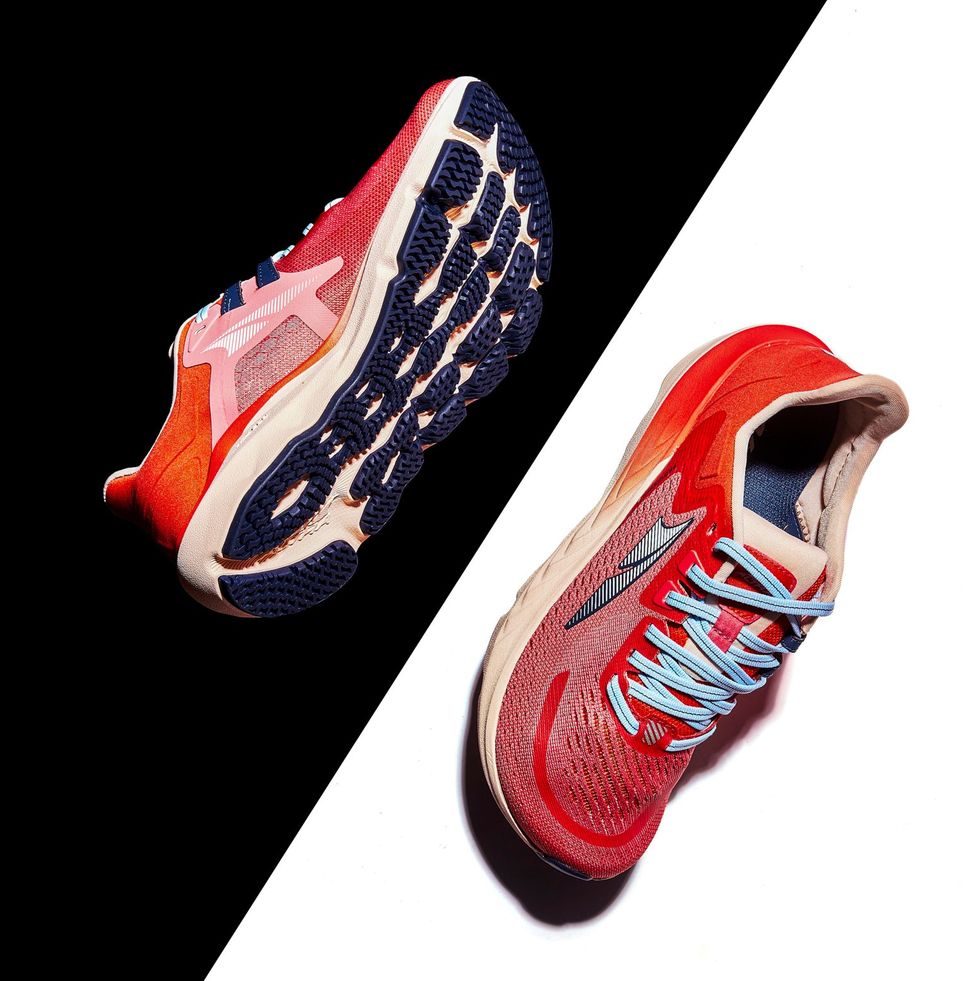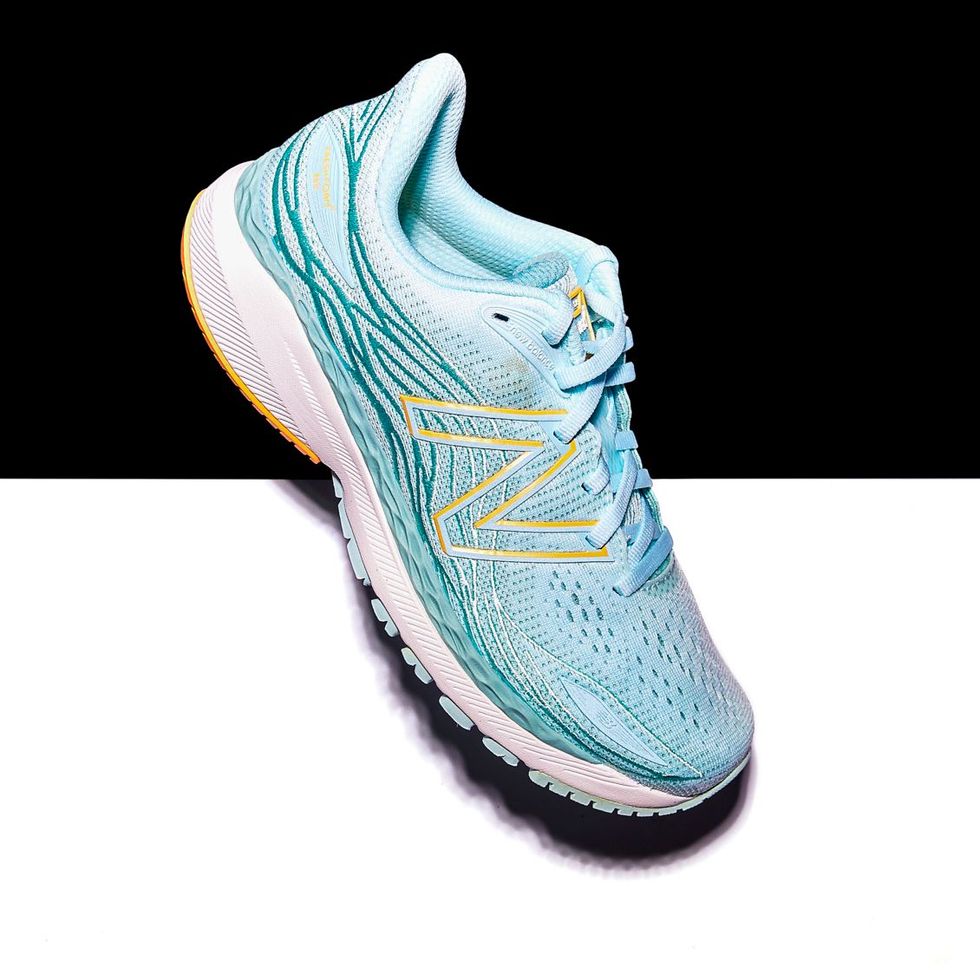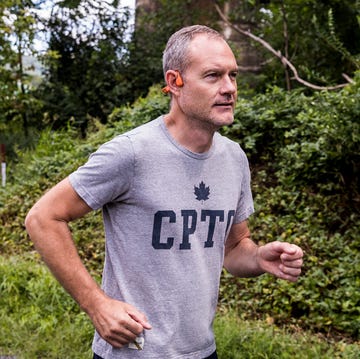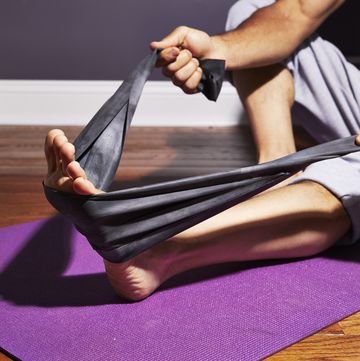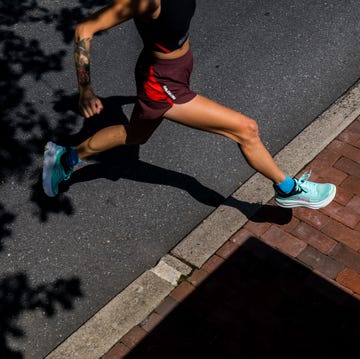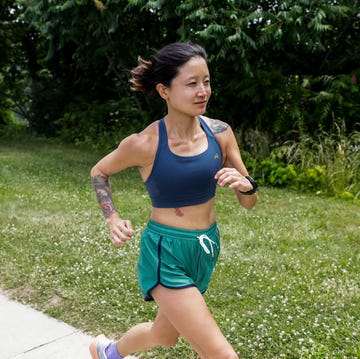Altra Provision 6
Weight: 9.0 oz (M), 7.7 oz (W)
Drop: 0 mm
Stability has taken on a new look in the Provision 6, the best version we’ve tested. Gone are the stabilipods, three-point stabilizers of firm foam on both sides of the forefoot and the lateral side of the heel. And the guide rail that wrapped around the border of the midfoot and heel is now virtually hidden and reinforced into the Ego midsole. In this way, the Provision, a stability shoe, looks like a neutral trainer. It also has a two-fingered medial strap, which connects the lacing to the footbed for a more secure hold. Some testers found the construction gave them a better sense of how and where their footfalls landed. Even if you don’t require such a level of control, your foot stays secure.
The shoe’s interior is just as accommodating. “The length and width were excellent with thick or thin socks,” said one tester. Performance-wise, the Provision feels as lightweight and responsive as a racing flat, yet amply cushioned for runners who prefer a minimalist shoe when logging long runs. “These Altras are light enough for the track and they are very ‘grippy’ due to the design and material of the outsole,” said a tester, whose evaluation included speedwork on the oval at 5-minute pace. “When I ran fast, I felt like my whole foot was rolling through ground contact and toe-off very naturally without losing any traction.”—Amanda Furrer
New Balance FuelCell Prism v2
Weight: 8.9 oz (M), 7.5 oz (W)
Drop: 6 mm
Stability shoes have been a dying breed, disappearing from store shelves. But, they’re not dead yet. And they’re not just for plodding along, either: Just look at the Prism, a lightweight, stable speedster that’s well suited for track sessions, tempo runs, and even racing. There used to be a slew of this kind of shoe—I still long for a fresh pair of Mizuno Wave Elixir 7—but few options remain: Asics continues to sell the Gel-DS Trainer and Saucony makes the Fastwitch, though that shoe is so lightweight it’s best relegated to short races. That’s why it’s refreshing to see the Prism as an option for runners who want that extra support on their hardest efforts.
On the surface, the Prism 2 may appear like the stability sibling of the Rebel v2, but the shoes have a radically different ride. The Rebel is bouncy, alive, and almost chaotic in its rebound. The first Prism was too soft, but the second iteration has been dialed in. Some testers say, paradoxically, that it feels firm but delivers all the cushioning they require. “I noticed a little compression in the foam, looking closely, but with well over 100 miles in this shoe I would expect that,” said one wear-tester who runs “backyard” ultramarathons. “But on long runs, my feet never felt sore or tired.”
Even our testers who typically wear neutral shoes found the underfoot comfort satisfactory. Many shoe manufacturers have ditched the medial post—a denser wedge of foam positioned under your arch—in favor of less-intrusive methods like guide rails and wider platforms. While the Prism 2 still has a post, it goes almost unnoticed when you’re hitting laps around the track.“As someone who runs competitively, while also having extremely flat feet, some shoes can be uncomfortable for me when running,” one of our collegiate wear-testers said, “but I’ve gotten through all of my workouts without any problem in these shoes, even after putting 200 miles on them.”—Jeff Dengate
New Balance Fresh Foam X 860v12
Weight: 11.0 oz (M), 8.8 oz (W)
Drop: 10 mm
Like its v11 predecessor, the 860v12 has two layers of Fresh Foam in its midsole—the top is soft, the bottom is speedy. New Balance tweaked the formula of the lower layer (an EVA-based material), slightly lowering the durometer—a measure of hardness. So in this version of the shoe, it feels a smidge more forgiving. That much is all good. But on the run, the new-school foams clashed with old-school stability tech, a dense medial post. It does the job to slow down pronation forces, but the extra weight slows the shoe’s ride, too. “I know this shoe is designed to be firm and has a loyal fan base that praises its cushioning, but for me, it was a bit too firm after about five or six miles,” one tester said.
For those in the market for stability shoes and trying to separate the masses, choose the 860 if getting a close-to-perfect fit is your top priority. That’s where this trainer takes the cake. The forefoot and toebox are wide and a little stretchy, spacious but not sloppy. It’s rare that not a single tester mentions a cramped pinky toe or hot spot in their sample pairs, but our testers raved that the 860’s fit was roomy yet locked down from heel to toe.—Morgan Petruny
Full 2022 Shoe Award Winners

Morgan is a gear editor who has been with Runner’s World since 2017. She started as an intern ghostwriting The Warmup, a bygone version of the daily RW newsletter. Now, she tests and reviews anything you might find on runners’ feet-from crew socks and compression boots to carbon-plated super shoes.
A lifelong runner and shoe geek, Morgan has been chasing the perfect pair of kicks since she joined her grade school cross-country team. Since then, she ran as a Division I walk-on for the cross-country and track & field teams at the University of Delaware, where she studied English and Biology. She has one full marathon under her belt, and has raced more halfs and 5Ks than she can count.
Amanda Furrer, Editor, Running Reviews, studied journalism at NYU and writing at Emerson College. She has reviewed gear and covered other topics in the running space for almost 10 years. Since 2013, she has consecutively run the Boston Marathon. She also has a master’s degree in gastronomy from Boston University and was formerly a professional baker for two years before hanging up her apron.
Jeff is Runner-in-Chief for Runner’s World and the director of product testing. He has tested and reviewed running shoes, GPS watches, headphones, apparel, and more for nearly two decades. He regularly tests more than 100 pairs of shoes each year, and once had a 257-day streak running in different models. Jeff can usually be found on the roads, racing anything from the mile to a marathon, but he also enjoys racing up mountains and on snowshoes. When he’s not running, you’ll probably find him hanging from a ladder making repairs and renovations to his house (he’s also director of product testing for Popular Mechanics).

